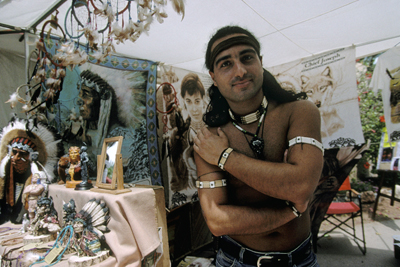The most interesting markets in photographic terms are those that sell fruit, vegetables, fish and meat to local people. The stall-holders and customers are ordinary people going about their normal daily lives, and the produce on sale is what local people eat. The golden rule is to go early when the best produce is piled high and the keenest-eyed customers are looking for the best deal. Potential images are everywhere. It is just a matter of capturing them successfully.
Feverish activity produces constant movement, change and obstruction of views. Market environment are generally confused, and this has to be accepted. They exist to supply people with food and the vendors are more concerned about their takings than assisting photographers. Contrast is always a problem on outdoor markets because some areas are directly lit and others are shaded by the canopies of stalls, coloured plastic sheeting and so on. Look for subjects that are well lit or in even shade, and be prepared to keep shooting. Opportunities come and go very rapidly and must be grabbed quickly.
 Most vendors will be too busy to bother about a photographer, but a few may object to the presence of a camera. Try to capture a few faces using a short telephoto lens and perhaps fill-in flash, because markets always seem to have a few local characters. Don’t spend too long in one place because even the most tolerant stall-holders eventually get tired of your attention. Buying some produce helps to promote a more positive attitude. It is also worth trying shots of the produce itself, particularly when it is colourful, different and well lit. Close-ups of fruit, vegetables and spices can make graphic images.
Most vendors will be too busy to bother about a photographer, but a few may object to the presence of a camera. Try to capture a few faces using a short telephoto lens and perhaps fill-in flash, because markets always seem to have a few local characters. Don’t spend too long in one place because even the most tolerant stall-holders eventually get tired of your attention. Buying some produce helps to promote a more positive attitude. It is also worth trying shots of the produce itself, particularly when it is colourful, different and well lit. Close-ups of fruit, vegetables and spices can make graphic images.
Wide-angle views of markets also work well because they show not only the vendors but also their produce and the broader environment. However, it can be very difficult to find suitable viewpoints and control background detail. Avoid excessive contrast and choose simple compositions with a single centre of interest. Keep the shutter speed at 1/125 sec or faster and maximize depth of field by using a reasonably fast film or digital ISO setting.
Arts and crafts markets are a somewhat different proposition. Since they are generally set up for tourists the customers are less likely to be local and hence make less interesting subjects, but the products may be colourful, reasonably genuine in nature and beautifully displayed. In addition, it may be possible to photograph the craftspeople at work. Show some interest in their work and ask permission if there is doubt about the acceptability of a camera. Look for colourful, well-lit displays, and patterns created by numerous similar items, and don’t be afraid to go in close to fill the frame.






